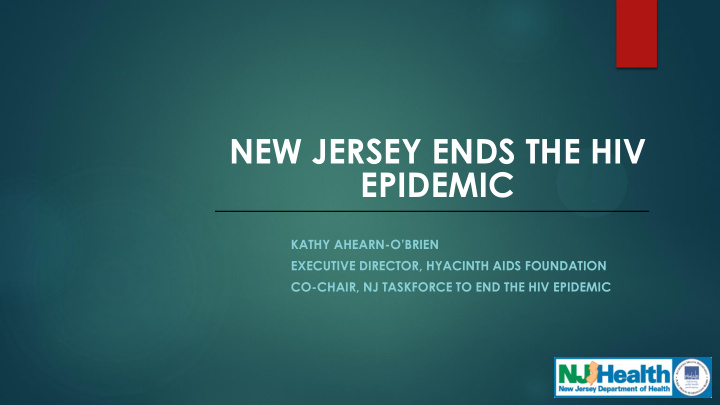



NEW JERSEY ENDS THE HIV EPIDEMIC KATHY AHEARN- O’BRIEN EXECUTIVE DIRECTOR, HYACINTH AIDS FOUNDATION CO-CHAIR, NJ TASKFORCE TO END THE HIV EPIDEMIC
Why Now? Over the last three decades, there has been rapid development of effective antiretroviral treatment. Pre-exposure prophylaxis (PrEP) and treatment as prevention (TasP) have created an opportunity for substantial progress towards ending the epidemic. NJ has adopted an integrated approach to HIV Care and Treatment and HIV Prevention.
Plan Development: Ending the Epidemic - Process World AIDS Day 2018: Governor Murphy called on stakeholders to join the Department of Health to work strategically to end the HIV/AIDS epidemic. Declared support for U=U. Formation of the NJ Taskforce to End the HIV Epidemic. Community members, NJDOH, community-based organizations, healthcare providers, academics/researchers, and advocates. o Representation from the NJ HIV Planning Group, the Governor’s Advisory Council on HIV/AIDS and other Blood- Borne Pathogens, RW Parts A/B/D/F, and the state’s many cross -part collaboratives. Creating the plan that will guide the beginning of the state’s ETE efforts.
Plan Structure
Overarching Goals By 2025, New Jersey will… Reduce the rate of new HIV infections by 75% (2016 baseline: 1. 1200). Ensure that 100% of persons living with HIV/AIDS know their status 2. (2016 baseline: 91%). Ensure that 90% of persons diagnosed with HIV/AIDS are virally 3. suppressed (2016 baseline: 51%). Subcommittees created for each goal, to determine objectives and strategies.
Innovative Initiatives Launched to fill gaps identified by consumers and providers in NJ’s HIV/AIDS prevention and care networks. Care Initiatives: Prevention Initiatives: • Trauma-Informed Care NJ Linkage to Care Program • • Community Health Worker NJ PrEP Counselor Program • Program Harm Reduction Expansion • • Behavioral Health and HIV Access to Reproduction Care • Integration Project (B-HIP) and HIV (ARCH) Nurse • DAYAM Screening, Treatment and Risk Reduction for Teens (START) • Project Nest • The Salon • NJ HIV Housing Collaborative (NJHHC)
Guiding Principles Indicate the plan’s values and guide implementation. They remind us that injustice and inequality must be at the forefront of our minds if we are to truly end the HIV epidemic in this state. Extreme Collaboration Community Building Sex Positivity Eliminating Stigma Addressing Systems of Oppression Cultural Humility Radical Engagement Trauma-Informed Care
Priority Populations There are certain populations that are disproportionately affected by HIV/AIDS that the Taskforce wanted to bring attention to. LGBTQ Individuals (gay and bisexual men, transwomen) Women (minority women and pregnant women) Persons Who Inject Drugs
Priority Communities Cities in NJ with the highest prevalence and/or incidence of HIV/AIDS that may be subject to specific or additional strategies during implementation. • Paterson • Jersey City • Easy Orange • Elizabeth • Irvington • Plainfield • North Bergen • Trenton • Union City • Camden • Newark • Atlantic City
Feedback Taskforce gathered feedback on these goals, barriers to these goals, and what New Jerseyans think is important to include in the plan, and what’s necessary to bring about the end of NJ’s HIV epidemic. Online and paper surveys. In-person and Facebook townhalls. Dedicated email inbox for feedback. Social media campaign. #NJEndsHIV2025
Survey Results Surveyed 382 individuals, the majority of which reported to be black/African American, heterosexual NJ residents between the ages of 25-34. Fifty-six percent of survey responses came from individual who work for a community-based HIV service provider or a healthcare-based HIV service provider. Of those surveyed: Twenty percent claimed stigma is the greatest factor that prevents their clients from getting tested for HIV, while another 20% claimed fear was the greatest factor.
Listening Sessions 4 Listening Sessions: Trenton, Newark, Camden and Atlantic City • Attended by 120+ people (not everyone signed in) • Largest meeting attended: Newark • Feedback MORE FUNDING EVERYWHERE Harm Reduction Elimination of the 1-for-1 syringe standard Safe injection sites Expanded/non-traditional hours More staff (including ARCH Nurses) Transportation Expanded access
Listening Sessions (Cont.) Housing More affordable, accessible housing (esp. for recovering IDUs) HOPWA issues statewide Leveraging other housing resources (Section 8 ) Miscellaneous Bring back the Speaker’s Bureau Re-engage the faith-based community Support services geared toward the aging population More relatable, sex-positive education/educational materials More job opportunities for HIV positive peers within the HIV community Update the statewide resource guide Engagement of the greater community – not just the HIV community Evaluation of stigma within the HIV community
Social Media Reach Twitter: Posts: 87 Retweets: 174 Likes: 321 Impressions (NJDOH posts): 92,780 Facebook: Posts: 26 Likes/reactions: 234 Shares: 155 Total people reached (NJDOH posts): 8,163 Facebook Live Session 4/29: Total likes/reactions: 44 Total comments: 44 Total shares: 25 Total views: 2,000 Instagram: Posts: 46 Likes: 719
Thank you! Kathy Ahearn- O’Brien Executive Director, Hyacinth AIDS Foundation 317 George Street, New Brunswick, NJ 08901 kobrien@hyacinth.org
Recommend
More recommend